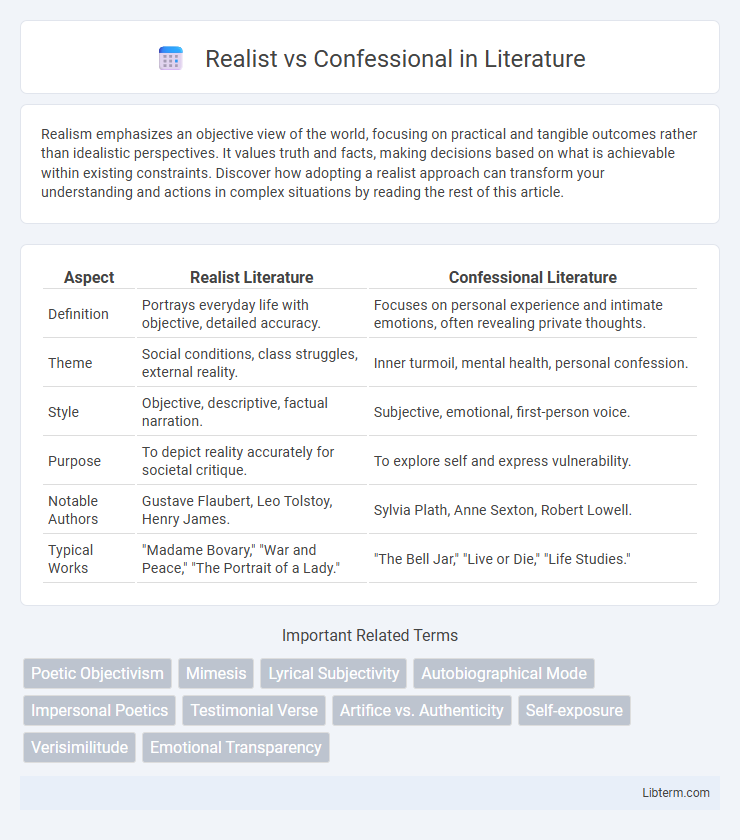Realism emphasizes an objective view of the world, focusing on practical and tangible outcomes rather than idealistic perspectives. It values truth and facts, making decisions based on what is achievable within existing constraints. Discover how adopting a realist approach can transform your understanding and actions in complex situations by reading the rest of this article.
Table of Comparison
| Aspect | Realist Literature | Confessional Literature |
|---|---|---|
| Definition | Portrays everyday life with objective, detailed accuracy. | Focuses on personal experience and intimate emotions, often revealing private thoughts. |
| Theme | Social conditions, class struggles, external reality. | Inner turmoil, mental health, personal confession. |
| Style | Objective, descriptive, factual narration. | Subjective, emotional, first-person voice. |
| Purpose | To depict reality accurately for societal critique. | To explore self and express vulnerability. |
| Notable Authors | Gustave Flaubert, Leo Tolstoy, Henry James. | Sylvia Plath, Anne Sexton, Robert Lowell. |
| Typical Works | "Madame Bovary," "War and Peace," "The Portrait of a Lady." | "The Bell Jar," "Live or Die," "Life Studies." |
Introduction to Realist and Confessional Poetry
Realist poetry emphasizes accurate, detailed depictions of everyday life, grounding its themes in observable reality and social issues. Confessional poetry delves into personal experience and intimate emotions, often revealing private struggles and psychological complexity. Both movements revolutionized modern poetry by prioritizing authentic expression, yet Realism centers on external truths while Confession focuses on internal truths.
Historical Background of Realist Poetry
Realist poetry emerged in the mid-19th century as a reaction against Romantic idealism, emphasizing everyday life and social realities with precise, unembellished language. Influenced by the broader Realism movement in literature and art, poets aimed to depict ordinary experiences and societal issues with clarity and objectivity. This historical context shaped Realist poetry to prioritize truthfulness and detailed observation over emotional exaggeration or spiritual introspection.
Origins and Evolution of Confessional Poetry
Confessional poetry originated in the late 1950s and early 1960s, emerging as a reaction against the impersonal nature of Modernist and Realist poetry by emphasizing personal experience, psychological depth, and vulnerability. Pioneers like Sylvia Plath, Robert Lowell, and Anne Sexton used intimate, autobiographical content to explore themes of mental illness, trauma, and identity, marking a significant evolution from the detached realism prevalent in earlier poetic forms. This shift redefined poetry's function as a means of raw self-expression and therapeutic revelation rather than objective social observation.
Key Characteristics of Realist Poetry
Realist poetry emphasizes accurate, detailed depictions of everyday life and ordinary people, focusing on social issues and the human condition without romanticization. It employs straightforward language, clear imagery, and objective tone to convey authentic experiences and societal truths. This style contrasts with confessional poetry's introspective, emotional, and personal narratives, prioritizing external reality over internal reflection.
Defining Features of Confessional Poetry
Confessional poetry is characterized by its raw emotional intensity, autobiographical content, and exploration of personal trauma and mental health issues, often revealing intimate details of the poet's life. Unlike Realist poetry, which emphasizes objective descriptions of everyday life and external realities, Confessional poetry uses first-person narratives to delve deeply into psychological states and subjective experiences. This genre frequently addresses themes such as death, depression, family dysfunction, and identity, aiming to evoke empathy through unfiltered self-expression.
Major Figures in Realist vs. Confessional Movements
Major figures in the Realist movement include Gustave Flaubert and Leo Tolstoy, whose works emphasize precise depictions of everyday life and social realities. In contrast, Confessional writers like Sylvia Plath and Robert Lowell focus on personal introspection, emotional intensity, and self-revelation in their poetry and prose. These distinctive approaches highlight realism's external observation versus confessionalism's internal subjectivity.
Thematic Differences: Realist vs. Confessional Works
Realist works emphasize objective representation of everyday life, focusing on social conditions, external realities, and the struggles of ordinary people, while confessional works delve into personal, emotional experiences, highlighting subjective truths and inner psychological states. Themes in realist literature often include social injustice, class conflict, and moral dilemmas, whereas confessional literature centers on identity, trauma, addiction, and intimate revelations. The difference lies in realist's external societal lens versus confessional's introspective, autobiographical perspective.
Stylistic Approaches in Both Traditions
Realist stylistic approaches emphasize detailed, objective descriptions and straightforward language to reflect everyday life and social realities, while confessional styles adopt an intimate, personal tone with introspective and emotional language to convey subjective experiences. Realism employs precise imagery and external observation, whereas confessional writing leans on lyrical expression, fragmented structures, and raw, candid narratives to explore inner turmoil and identity. These contrasting techniques shape how both traditions engage readers by either portraying external truths or internal authenticity.
Cultural Impact and Legacy
Realist literature, emphasizing objective representation and ordinary lives, profoundly influenced cultural movements by challenging romanticized narratives and promoting social awareness. Confessional poetry, with its intimate exploration of personal trauma and psychological depth, reshaped cultural norms by fostering vulnerability and mental health discourse. The legacy of both genres persists in contemporary literature, highlighting realism's societal critique and confessionals' emotional authenticity as pivotal to modern storytelling.
Choosing Between Realist and Confessional Styles
Choosing between Realist and Confessional styles depends on the desired authenticity and emotional depth in storytelling. Realist style emphasizes objective representation of life through detailed, lifelike portrayals, making it ideal for narratives seeking factual accuracy and social commentary. Confessional style centers on personal experiences and introspective honesty, appealing to audiences drawn to psychological intimacy and emotional vulnerability.
Realist Infographic

 libterm.com
libterm.com